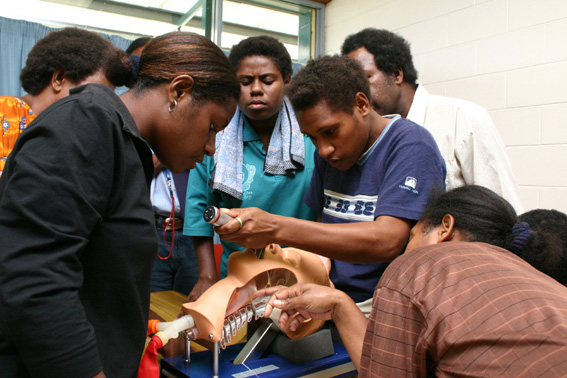
Snakebite Education & Training in Papua New Guinea
Southern Papua New Guinea has some of the highest incidence and mortality rates for snakebite in the world. Some communities in Central Province has incidence rates of more than 1.2 cases per 1,000 population, and mortality rates as high as 33 cases per 100,000 population have been recorded. Since the 1980’s adult in-hospital case fatality rates have risen from 3.3% to 14.5%, and corresponding paediatric case fatality rates have risen from 7.7% to 25.9%.

The problems are compounded by a 40.2% decline in antivenom availability over the past two decades, and an increase of 884% in local antivenom costs. Snakebites account for 45% of ICU admissions in Port Moresby General Hospital, and 60% of ventilator bed days; largely because antivenom administration is delayed in the referring Health Centres (or is simply unavailable).
Misconceptions about snakebite are widespread, and there is common use of inefficacious and sometimes dangerous first aid measures and traditional remedies, which causes delays in seeking effective care. A survey of health worker in 2004 found there were many deficiencies in basic knowledge. Many health workers did not the basic skills to treat snakebite effectively. For example, only 33.8% of survey respondents knew the correct procedure for performing the basic 20 minute Whole Blood Clotting Test (20WBCT) that is an essential early diagnostic tool, and 61.3% incorrectly listed non-specific symptoms and signs as a justification for giving antivenom.
A large clinical review of more than 1,800 cases revealed that major shortcomings in the treatment of snakebite at rural health facilities. A large proportion of health workers had poor basic resuscitation skills, and in a study of antivenom use, only 44% of potentially life-threatening early adverse antivenom reactions were recognised and treated. This situation has been compounded by the fact that the Adult and Paediatric Standard Treatment Guidelines have previously contained now outdated and differing management protocols.
Forging solutions
In response to these problems, NDoH-sponsored clinical toxinologist, David Williams, and visiting UPNG Senior Lecturer in Emergency Medicine, Dr Simon Jensen set out in 2004 to develop a National training course in the treatment and management of the bites and stings of venomous snakes and other toxic animals.
The philosophy behind the course is that the declining prognosis of snakebite patients can be reversed if key issues, including health worker and community education and training, are addressed with situationally relevant education and training.
The inaugural National Snakebite Management Course was conducted at the UPNG School of Medicine and Health Sciences in Port Moresby in September 2004. Taught by a volunteer faculty of physicians and snakebite specialists from Australia & PNG the course was aimed at rural HEO’s, CHW’s and NO’s, and hospital-based doctors and NO’s.
The Curriculum
The course emphasises situational relevance and is based on the teaching of techniques appropriate to the available medical resources and skill levels of the health workers. Fundamental components of the course include structured lectures dealing with:
Many of the basic skills taught at the course, such as basic resuscitation skills, are of general benefit to the health workers in their management of other acute medical conditions. The lectures presented at the course are complimented by several practical workshops that include:
The Snakebite Management Course is preceded by survey of participant’s current knowledge and perceptions of snakebite and its treatment, and the results of these surveys are used to guide future curriculum development. Courses are concluded by a written examination. In 2004 and 2005 the average grade awarded was 71.3%.In 2004 the course was accompanied by a 200 page A4 manual for participants to retain and use as a resource. In 2005 a specific handbook “Venomous bites and stings in Papua New Guinea” was published to replace the original manual.
Course organiser: Mr David Williams
| Introduction | Research | Species Accounts | PDF Library | Care sheets | Film & Television | Links | Contact |
Except where stated otherwise all site content © David Williams (1998-2007)